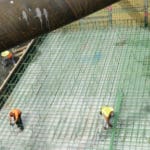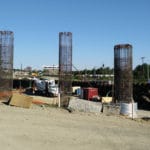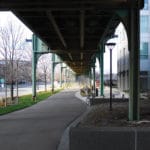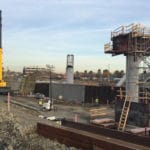Complex geotechnical engineering design to support a 4-mile rail line extension
Over a period of 3 -years, Nobis provided comprehensive geotechnical engineering services for the Massachusetts Bay Transit Authority (MBTA) as part of a $1.1 Billon 4.3-mile Green Line Extension (GLX) light rail project. This project extends the A Green Line from Cambridge, MA to Somerville, MA and included seven new rail stations and a new vehicle maintenance facility. Portions of the GLX are elevated on multiple viaducts comprising 60 total spans, five highway bridges extend over the rail lines, and a railroad bridge crossing over an existing roadway will be replaced. Portions of the rail corridor improvements will be constructed within cut sections requiring 3 miles of soldier piles and cantilevered retaining walls.
Nobis developed and conducted a significant subsurface exploration and drilling program within the active rail corridor and completed a geotechnical laboratory testing program to subsurface materials including stratigraphy, soil and rock strength parameters, settlement characteristics, soil liquefaction potential, and groundwater implications.
Detailed basis-of-design geotechnical analyses were conducted by Nobis for deep foundations including drilled shafts, micro piles, and driven piles, cantilevered and anchored retaining walls systems, ground improvement to stabilize soft soils with aggregate piers, and axial load testing.
Challenges
- The geotechnical subsurface explorations called for advancing 280 test borings to depths of up to 200 feet in an aggressive schedule of only 14 months within an active rail corridor and a dense urban setting. Extensive coordination was required to gain access, avoid impacts to rail operations, and to provide safe working conditions.
- Variable soil conditions and decomposed bedrock formations, high viaduct loads, limited access for large construction equipment, and working within an active rail environment required innovative approach for the viaduct foundation systems.
Solutions
- To successfully complete the test boring program, Nobis assigned a full-time field operation lead and multiple drilling teams to meet the schedule, and proactively coordinated each needed property access and scheduled all railroad protections by the rail operator.
- To address the challenging subsurface conditions, Nobis conducted advanced load modeling, and shear forces and moments on the 120-feet deep viaduct foundations. The team weighed schedule impacts, constructability, and cost implications and ultimately proposed a variety of foundation types – drilled shaft, driven piles, and micro piles to allow train service to remain active during construction.
Results
Project construction is now underway. Once completed, the Green Line Extension is projected to have a total weekday ridership of about 52,000, including 7,000 to 8,000 new riders.



